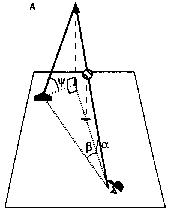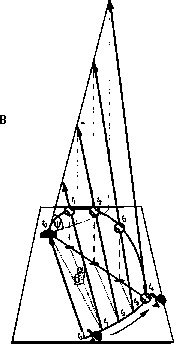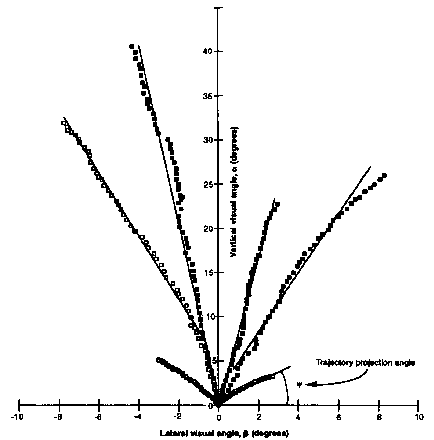 |
Figure 2. The LOT model. This model specifies
that fielders "control" the optical direction of ascent of the
ball by adjusting their running path to null optical trajectory corvature.
This keeps the image of the ball continuously ascending in a straight line
throughout the trajectory.
(A) Fielder optical angle geometry of a ball at an instant in
midflight: a = vertical optical angle, b
= horizontal optical angle, and Y = optical
trajectory projection angle (angle from the perspective of the fielder
that is formed by the ball, home plate, and a horizontal line emanating
from home plate). The configuration of Y,
a, and bforms a right
pyramid such that tan Y = (tan
a)/(tan b). a and
b are both controlled to increase continuously throughout the trajectory
and are also labeled at time t1 in (B).
|
 |
(B) Bird's-eye view of a fly ball with a running
path that maintains a linear optical ball trajectory (positions shown at
times t0 through t4). If the fielder maintains
a constant increase in the lateral optical tangent, tan b,
he achieves approximate horizontal alignment with balls that are catchable.
When he runs along a path so that both lateral and vertical tangents increase
at a constant rate then the trajectory projection angle Y
remains consttant. Mathematically, the relation is expressed as tan
Y = tan a
= Caf(t)
= CY
tan b Cbf(t)
where Ca, Cb,
and CY are constants
and f(t) = t = time since trajectory initiation. In theory, f(t)
could be any monotonically increasing function, but for approximately parabolic
trajectories, f(t) = t leads to a relatively constant bearing and a near
least energy running path. The fielder scales lateral running speed
relative to his distance to home plate, which generally results in a running
path that curves slightly. The resultant optical trajectory is represented
behind the ball by the tilted line rising from home plate. |


